Philips Bundle
How Does Philips Dominate the Health Technology Market?
From its humble beginnings in lighting to its current status as a healthcare technology giant, Philips has undergone a remarkable transformation. This evolution underscores the critical role of its sales and marketing strategies in achieving and maintaining its market leadership. Understanding Philips' approach offers valuable insights for businesses aiming to navigate the complex landscape of modern healthcare.
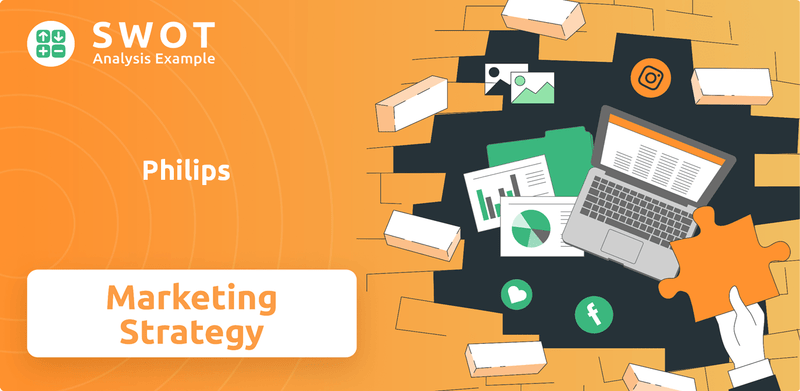
This article will explore the Philips SWOT Analysis to reveal how Philips' sales strategy, marketing strategy, and overall business strategy contribute to its success. We'll examine Philips' brand positioning, its innovative Philips products, and its impressive market share, alongside its marketing channel strategy and digital marketing strategy. You'll discover how Philips leverages its customer relationship management to maintain a competitive advantage, and the impact of its pricing strategy analysis on its sales performance review.
How Does Philips Reach Its Customers?
The company employs a multi-channel sales strategy to effectively reach its diverse customer base. This approach includes a blend of online and offline channels, reflecting a strategic shift towards digital adoption and omnichannel integration. The company's strategy focuses on reaching consumers through e-commerce platforms and direct online sales, especially in regions where digital shopping is prevalent.
The company's website offers detailed product information, reviews, and multimedia content to support the customer's decision-making process. Beyond its direct online presence, the company utilizes physical retail locations, wholesale distributors, and partner retailers. Strategic partnerships are crucial for distributing medical equipment, with collaborations with hospitals, clinics, and healthcare providers.
The evolution of these channels reflects a strategic shift towards digital adoption and omnichannel integration. The company has invested in creating a user-friendly and secure online shopping experience, recognizing the importance of digital channels for driving online sales and connecting with consumers. This digital transformation has seen the company bring more digital capabilities in-house and align teams to drive better results, with an increased focus on e-commerce and direct-to-consumer sales.
E-commerce platforms and direct online sales are key components of the company's sales strategy. The company's website offers detailed product information, reviews, and multimedia content. In 2024, the company aimed to grow its global direct-to-consumer (D2C) channels.
The company utilizes physical retail locations, wholesale distributors, and partner retailers to reach customers. Strategic partnerships with hospitals, clinics, and healthcare providers are crucial for distributing medical equipment. The company also creates innovative retail environments to showcase products and educate consumers.
The company has been exploring quick commerce platforms, with a pilot program with Zepto and plans to partner with Blinkit. However, these are not yet a core part of its key strategy. This expansion reflects a focus on adapting to evolving consumer preferences and market trends.
The company has invested in creating a user-friendly and secure online shopping experience. This digital transformation has seen the company bring more digital capabilities in-house. For instance, in its personal grooming segment, 50% of sales happen online, indicating a significant digital presence.
The company focuses on digital channels to drive online sales and connect with consumers, with an increased emphasis on e-commerce and direct-to-consumer sales. The company's use of platforms like Omnia Retail to manage pricing across multiple channels and countries has led to higher conversions and success in its D2C channel.
- The company's digital marketing strategy includes a strong focus on its e-commerce platform and direct-to-consumer sales.
- The company leverages platforms like Omnia Retail for pricing management across multiple channels, leading to higher conversion rates.
- Price-related complaints reportedly reduced by 75% after implementing Omnia Retail.
- The company's digital transformation involves bringing more digital capabilities in-house and aligning teams for better results.
Philips SWOT Analysis
- Complete SWOT Breakdown
- Fully Customizable
- Editable in Excel & Word
- Professional Formatting
- Investor-Ready Format
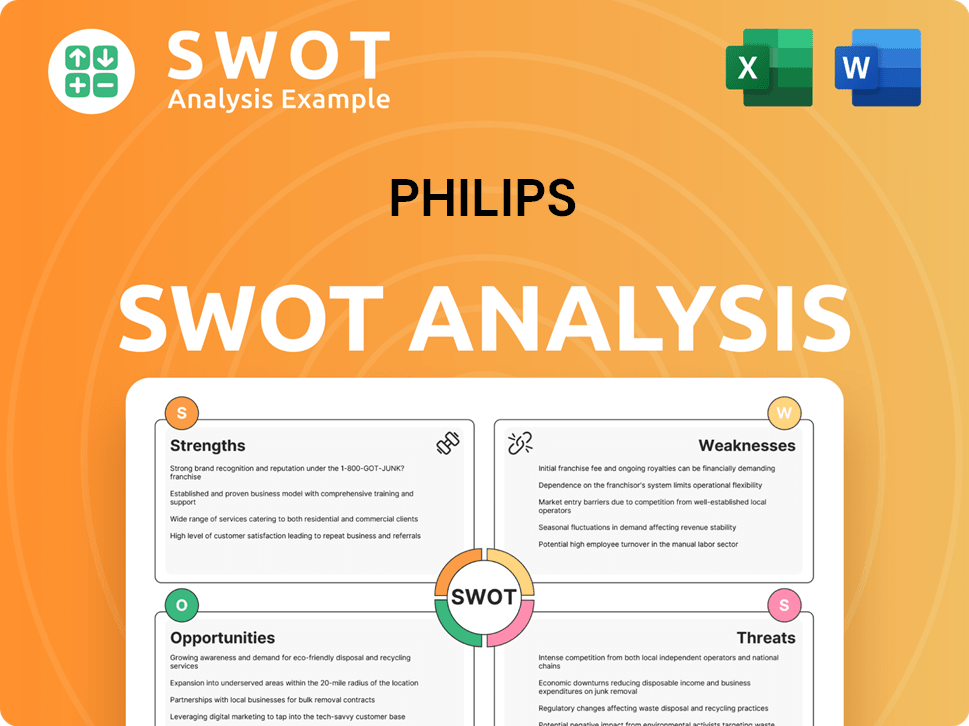
What Marketing Tactics Does Philips Use?
The marketing tactics employed by the company are diverse, encompassing both digital and traditional methods. This integrated approach aims to boost brand awareness, generate leads, and ultimately drive sales. The company's strategy is heavily reliant on data analytics and customer relationship management to refine its marketing efforts.
Digital marketing is a cornerstone of the company's strategy. This includes content marketing, search engine optimization (SEO), paid advertising, and email marketing. Social media platforms are actively used for consumer engagement, while influencer partnerships play a crucial role in reaching new audiences. The company also utilizes traditional media such as TV, radio, and print.
A data-driven approach is central to the company's marketing strategy. Advanced analytics, artificial intelligence (AI), and customer relationship management (CRM) systems are used to gain insights into consumer behavior. This enables customer segmentation and personalization, delivering tailored content and product recommendations. The company's collaboration with Google Cloud, leveraging Vertex AI, has significantly improved its digital asset management.
Content marketing, SEO, paid advertising, and email marketing are key components. The company creates content like recipes and health tips to position itself as a trusted source. Owners & Shareholders of Philips can find more insights on the company's overall performance.
Actively uses platforms like Instagram, Facebook, and Twitter for consumer engagement. Influencer partnerships are crucial for reaching new audiences and building credibility. In 2025, the company India is focusing on niche influencer marketing.
Utilizes TV, radio, print, and events as part of its multi-channel marketing approach. This ensures a broad reach across various consumer segments. This helps in maintaining a strong brand presence.
Employs advanced analytics, AI, and CRM systems to understand consumer behavior. This approach enables customer segmentation and personalization. This leads to improved marketing ROI.
Collaboration with Google Cloud, leveraging Vertex AI, has revolutionized digital asset management. The company has processed over 200,000 images, consolidating them into 8,000 unique assets. This significantly reduces operational costs.
Tailored content and product recommendations are delivered based on previous purchases and browsing history. This increases the relevance of marketing messages. This improves customer engagement.
The company's marketing strategy is a blend of digital and traditional methods, emphasizing data-driven insights and customer engagement. This integrated approach helps in achieving its business goals.
- Content marketing and SEO to enhance online visibility.
- Social media engagement and influencer partnerships for broader reach.
- Utilizing traditional media channels for comprehensive coverage.
- Leveraging data analytics and AI for personalized customer experiences.
- Focus on niche influencer marketing in specific regions, like India.
Philips PESTLE Analysis
- Covers All 6 PESTLE Categories
- No Research Needed – Save Hours of Work
- Built by Experts, Trusted by Consultants
- Instant Download, Ready to Use
- 100% Editable, Fully Customizable
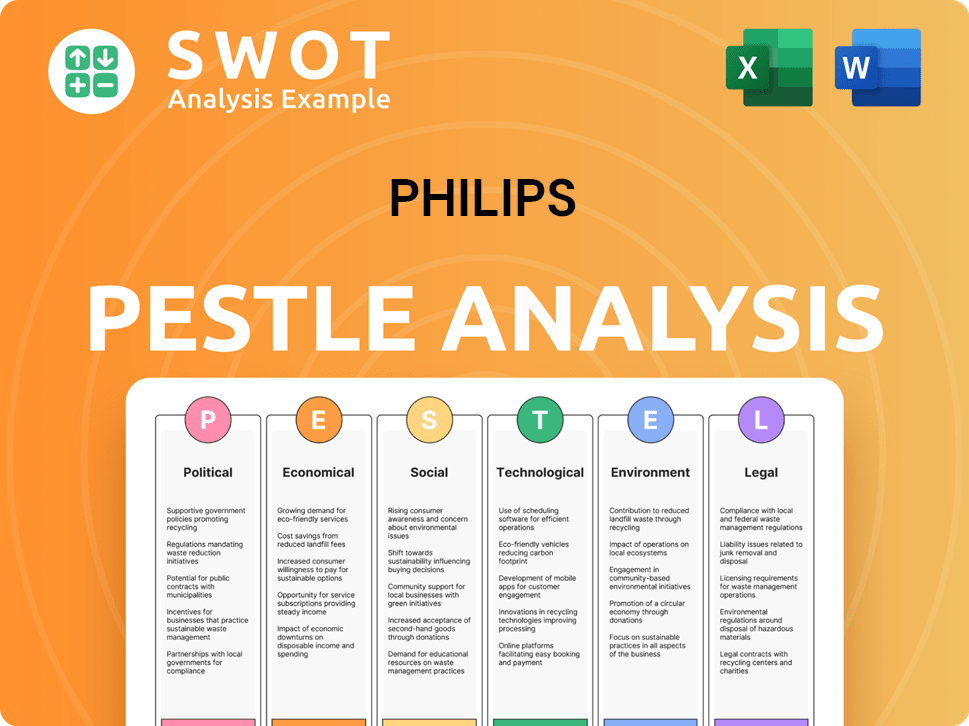
How Is Philips Positioned in the Market?
The brand positioning of the company centers on improving people's health and well-being, establishing itself as a health technology leader. This is achieved through meaningful innovation, with a strong emphasis on technological advancements and customer-centric solutions. The company's core message highlights innovation, sustainability, and a focus on the customer, setting it apart in the market.
The company appeals to its target audience by directly addressing consumer needs and creating an emotional connection through its products. Sustainability and Corporate Social Responsibility (CSR) are integral to its brand identity, with a commitment to reducing environmental impact. The company's approach is designed to resonate with consumers by focusing on how its products improve health and well-being, which is a key element of its Competitors Landscape of Philips.
Brand consistency is maintained through an integrated marketing communications (IMC) strategy, ensuring a unified brand voice across all channels. While maintaining global brand consistency, the company also adapts its marketing campaigns to resonate with local audiences, taking into account cultural nuances. This approach helps to strengthen its market position and build trust with consumers worldwide.
The company consistently highlights its technological advancements in its campaigns, positioning itself as a leader in health and well-being. The company's commitment to innovation is evident in its substantial investment in research and development, approximately EUR 1.7 billion in 2024.
Sustainability is a key aspect of the brand, with initiatives like the next-generation BlueSeal helium-free MRI system. In 2024, circular revenues comprised 24% of total sales, reflecting a growing emphasis on reducing electronic waste and promoting sustainable consumption.
The company focuses on how its products improve health and well-being, directly addressing consumer needs. This approach creates an emotional connection with the target audience, fostering brand loyalty and trust.
The company emphasizes transparency about its plans and commitment to safety and quality, particularly after challenges like the recall of some CPAP machines. This helps regain consumer confidence and reinforces its commitment to customer well-being.
The company's brand positioning is characterized by several key elements that work together to create a strong market presence and build consumer trust.
- Innovation: Continuous investment in R&D to lead in health technology.
- Sustainability: Commitment to reducing environmental impact and promoting circular economy models.
- Customer Focus: Products and campaigns centered on improving health and well-being.
- Transparency: Open communication about product safety and quality.
Philips Business Model Canvas
- Complete 9-Block Business Model Canvas
- Effortlessly Communicate Your Business Strategy
- Investor-Ready BMC Format
- 100% Editable and Customizable
- Clear and Structured Layout
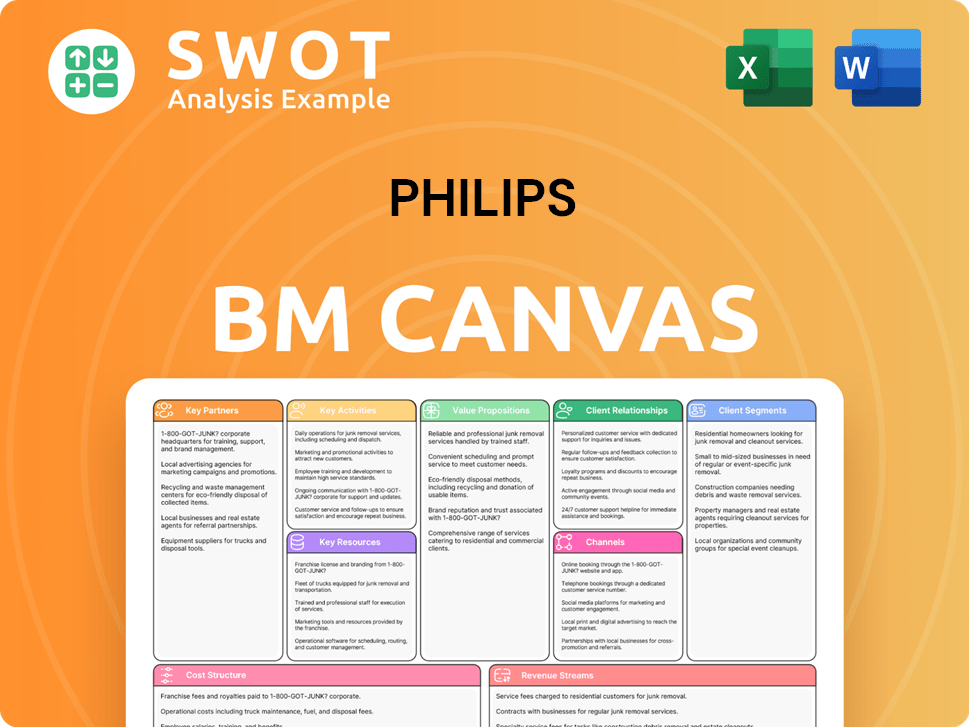
What Are Philips’s Most Notable Campaigns?
The company has consistently launched impactful sales and marketing campaigns, demonstrating its commitment to innovation and customer-centricity. These campaigns are designed to resonate with consumers by highlighting how its products enhance health, well-being, and overall quality of life. This approach has helped establish a strong brand identity and drive market growth, solidifying its position in the global market.
A key aspect of the company’s marketing strategy involves adapting global campaigns to local markets, ensuring relevance and effectiveness across diverse regions. By tailoring its messaging and product offerings to meet specific consumer needs, the company enhances engagement and strengthens its brand presence. This strategy is crucial for maintaining a competitive edge and expanding its market share worldwide. The company's success is also tied to its ability to integrate digital and physical retail experiences, providing seamless customer journeys.
The company's focus on consumer health solutions is evident in its campaigns. The integration of digital tools like the Sonicare and NutriU apps shows its commitment to empowering consumers through technology. These initiatives not only enhance the user experience but also provide valuable data for product improvement and personalized health recommendations. This strategy helps to foster long-term customer loyalty and drive repeat purchases, contributing to sustained revenue growth and market leadership.
This campaign showcased real-life examples of how the company's products improve health and well-being. It addressed consumer needs directly, fostering an emotional connection. The campaign was adapted for various regional contexts, demonstrating the company's balance of global consistency and local relevance. This approach helped build brand trust and recognition.
The launch of the OneBlade utilized an integrated marketing communications strategy. It employed a consistent message across social media, influencer partnerships, and user-generated content. In 2024, the company collaborated with Boots, a UK retailer, on a digital out-of-home campaign. This campaign allowed consumers to virtually try new beard styles.
This campaign highlighted the health benefits of homemade juices and smoothies. It involved partnerships with nutritionists and health influencers. The campaign's content included recipes, health tips, and instructional videos shared across social media platforms and the company's website. This approach positioned the company as a trusted source of health and wellness information.
The company has focused on personalized consumer health solutions, such as the Sonicare app. The app allows users to manage daily oral care and share data with dental practitioners. The NutriU app, for smart blenders, acts as a personal nutrition coach. These initiatives demonstrate the company's commitment to empowering individuals to take control of their health through intelligent technology.
The company's marketing strategy is multi-faceted, focusing on innovation, customer-centricity, and digital integration. It leverages various channels, including social media, influencer partnerships, and in-store experiences, to reach a broad audience. The strategy also emphasizes the creation of valuable content, such as recipes and health tips, to position the company as a trusted source of information. This approach has helped the company to maintain a strong position in the market. For more insights, you can check out the Brief History of Philips.
- Innovation: Continuous development of new products and technologies.
- Customer-Centricity: Focus on understanding and meeting consumer needs.
- Digital Integration: Utilizing digital platforms for marketing and sales.
- Content Marketing: Creating valuable content to engage and inform consumers.
- Partnerships: Collaborating with influencers and retailers to expand reach.
Philips Porter's Five Forces Analysis
- Covers All 5 Competitive Forces in Detail
- Structured for Consultants, Students, and Founders
- 100% Editable in Microsoft Word & Excel
- Instant Digital Download – Use Immediately
- Compatible with Mac & PC – Fully Unlocked
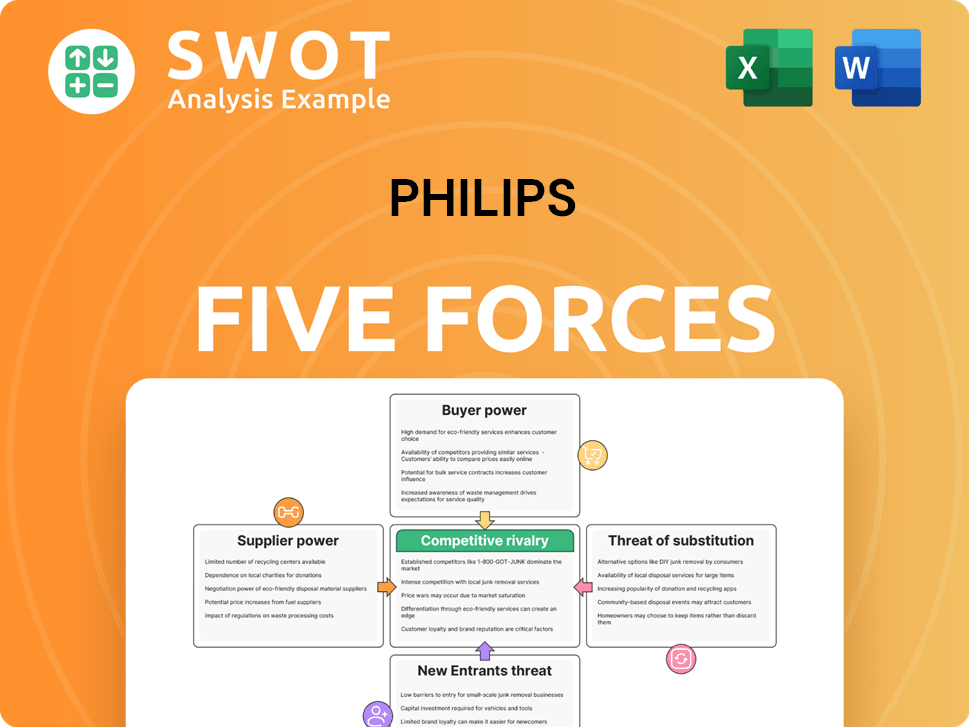
Related Blogs
- What are Mission Vision & Core Values of Philips Company?
- What is Competitive Landscape of Philips Company?
- What is Growth Strategy and Future Prospects of Philips Company?
- How Does Philips Company Work?
- What is Brief History of Philips Company?
- Who Owns Philips Company?
- What is Customer Demographics and Target Market of Philips Company?
Disclaimer
All information, articles, and product details provided on this website are for general informational and educational purposes only. We do not claim any ownership over, nor do we intend to infringe upon, any trademarks, copyrights, logos, brand names, or other intellectual property mentioned or depicted on this site. Such intellectual property remains the property of its respective owners, and any references here are made solely for identification or informational purposes, without implying any affiliation, endorsement, or partnership.
We make no representations or warranties, express or implied, regarding the accuracy, completeness, or suitability of any content or products presented. Nothing on this website should be construed as legal, tax, investment, financial, medical, or other professional advice. In addition, no part of this site—including articles or product references—constitutes a solicitation, recommendation, endorsement, advertisement, or offer to buy or sell any securities, franchises, or other financial instruments, particularly in jurisdictions where such activity would be unlawful.
All content is of a general nature and may not address the specific circumstances of any individual or entity. It is not a substitute for professional advice or services. Any actions you take based on the information provided here are strictly at your own risk. You accept full responsibility for any decisions or outcomes arising from your use of this website and agree to release us from any liability in connection with your use of, or reliance upon, the content or products found herein.